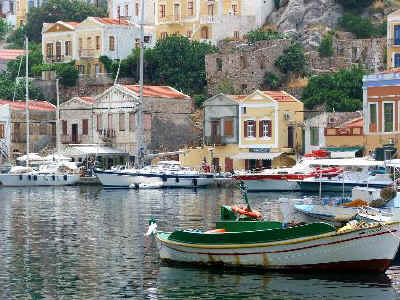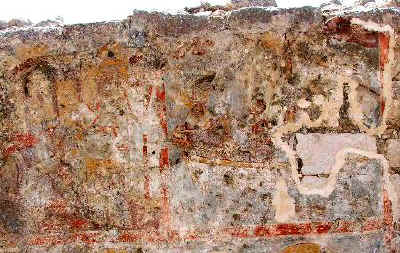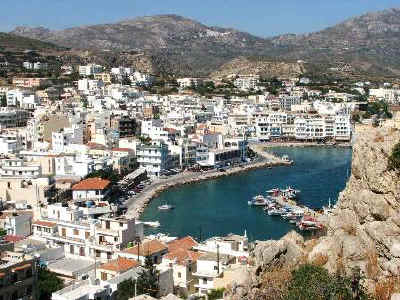 |
 |
 |
 |
Symi is often our first or last stop in Greece
and this was our third visit. The small harbor town is easy for handling the
paperwork of entering a new country. We couldn't be in the neighborhood and
not stop by anyway; Symi is a great place to spend a few days, if you don't
need to accomplish much.
Once a wealthy island, the demise of its sponge-fishing and boat-building industries caused most of the population to find accommodation elsewhere. There's no archaeology to speak of, day tourists from Rhodes make up most of the transient population, and the beaches aren't enticing enough to attract sunbathers. So we can sit in the café behind the boat, drink Greek coffee, and ogle the visitors. That's Swept Away, docked in front of the beige neo-Classical building with dark shutters across the harbor. |
||
| Chalki was once a sponge-fishing
center, but political upheaval and a sponge blight left much of the populace
without employment. Many of the sponge fisherman took Florida up on its
relocation offer. Now the city of Tarpon Springs, Florida is filled with the
descendants of Chalki expatriates.
The mosaic pebble design of choklakia began in Byzantine times and is a characteristic feature of the Dodecanese, especially its churches. Residents would keep the pebbles wet to cool off buildings in the hot Mediterranean summers. Early designs were geometric, like the circle at right. Later designs depicted aspects of local life, such as ships and fish. Above this circle mosaic, at the Saint Nicholas Church (Agios Nikolaos) above Chalki's harbor, you can see an example of later times in the form of birds atop the tree of life. |
 |
||
 |
Chalki is also home to a Crusader castle high in
its mountains. At one time, this area was the main town of the island. It
was common in the Aegean islands to maintain the port, but to secure the
population well up the mountain in its own town, most often called Chorio.
Here in Chalki, at least, there was already good fortification left over
from medieval times.
Several Byzantine frescos were still visible in the ruins of the castle's chapel. In the panels pictured, you can nearly make out the standing people at left and two people in a small boat on the right side. |
||
| The island of Karpathos was once
called Porfiris after the locally made red dye, but its present name is
probably a reference to the many robberies that took place there when it was
a pirate lair during the Middle Ages. Now, like the rest of the islands of
the Mediterranean, the only non-commercial, non-military boats are for
pleasure, not piracy, and the profiteering is accomplished primarily onshore
at the many restaurants, cafés, and shops along the waterfront. Karpathos maintained its relative quiet for many years while tourists swarmed to better-known Greek islands, but it is now a busy vacation spot. Many foreigners we came across were from Scandinavia and the Netherlands. We assume that late spring is their favorite season to visit Greece and that they want to be home when summer finally arrives up north. |
 |
||
 |
Until very recently, the mountain town of
Olympos at the top of Karpathos was very secluded and maintained its own
culture. But the old but still working windmills and the bright costumes
worn by the ladies were too appealing to remain a secret to tourists. Now, a
daily boatload of tourists descends on the little town of concrete houses
with carved balconies along streets only wide enough for donkeys.
Once a totally matriarchal society (even the name was of feminine gender), in today's Olympos, the mother passes on her property to the first-born daughter and the father to his son. |
||
| This man is playing a tsampouras, an instrument that looks as though a wooden horn swallowed a large rodent. The center of the instrument is made of goatskin, and the ends of wood. There are several holes in the outer end for the musician to cover in various combinations to make different sounds. Like a bagpipe, the musician blows air into the bag to fill it up, and the escaping air later makes the mournful tune. |  |
 |
This is a typical costume worn by the local Olympos ladies. It consists of a white blouse covered with a black jacket and a brightly embroidered apron over pantaloons. Though this woman is in sandals, most of them wear boots, even in summer (it's cool on Mount Olympos). The boots cover the calves with sheepskin, yet the delicate and ornate shoe portion of the boot looks like the ruby slippers on Dorothy in the Wizard of Oz. |